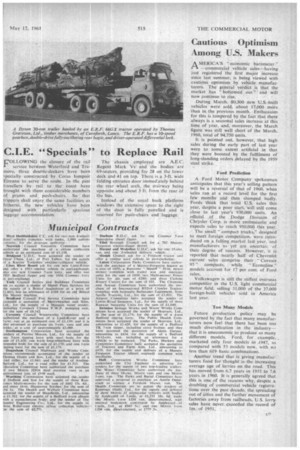Cautious Optimism Among U.S. Makers
Page 45

If you've noticed an error in this article please click here to report it so we can fix it.
AMERICA'S "economic barometer" —commercial vehicle sales—having just registered the first major increase since last summer, is being viewed with cautious optimism by vehicle manufacturers. The general verdict is that the market has "bottomed out "' and will now continue to rise.
During March, 80,300 new U.S.-built vehicles were sold, about 17,000 more than in the previous month. Enthusiasm for this is tempered by the fact that there always is a seasonal sales increase at this time of year, and, moreover, the March figure was still well short of the March. 1960, total of 94,750 units.
It is pointed out, however, that high sales during the early part of last year were to some extent artificial in that they were boosted by the fulfilment of long-standing orders delayed by the 1959 steel strike.
Ford Prediction A Ford Motor Company spokesman anticipates that this year's selling pattern will be a reversal of that of 1960, when sales ran at a record level for the first few months and then slumped badly. Fords think that total U.S. sales this year, despite a poor start, will still come close to last year's 930,000 units. An official of the Dodge Division of Chrysler Corp. is more enthusiastic and expects sales to reach 950,000 this year.
The small " compact trucks." designed to meet foreign competition, were introduced on ,a falling market last year. and manufacturers as yet are uncertaii. of their degree of success. However, it is reported that nearly half of Chevrolet current sales comprise their " Corvair, 95" compacts, while " Econoline" models account for 17 per cent. of Ford sales. _ Volkswagen is still the stiffest overseas competitor in the U.S. light commercial motor field, selling 31.000 of the 37,000 foreign-built vehicles sold in America last year.
Too Many Models • Future production policy may be governed by the fact that many manufacturers now feel that there has been too much diversification in the industry— that it is uneconomic to produce so many different models. Ford, for example, marketed only four models in .1947, as compared with 53 models now, with no less than 619 basic combinations.
Another trend that is giving manufacturers food for thought is the increasing average age of lorries on the road. This has moved from 6.7 years in 1955 to 7.6 years in 1960. It is generally agreed that this is one of the reasons why, despite a doubling of commercial vehicle registrations over the past decade, the spreading out of cities and the further movement of factories away from railheads, U.S. lorry. sales have never exceeded the record of Im. of 1951,
























































































































